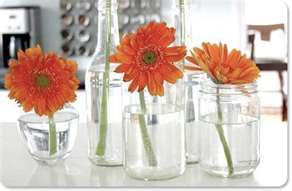GLASS RECYCLING MONTH
Through closed-loop recycling, glass sets the standard for recycling. This is done by recycling glass into new bottles and jars etc. Glass is infinitely recyclable, made from all natural ingredients and has a 400 year safety record.
Glass as a container is great, it does not harm the contents; is microwavable; does not corrode; does not stain and can last forever. The best thing about glass though is that it is 100% RECYCLABLE! So why would you want your glass to end up in a land fill where it will sit forever as glass is not biodegradable, instead of recycling it and creating a new glass product without harming the environment?
A few facts about recycling glass:
- Glass bottles and jars are 100% recyclable and can be recycled endlessly without any loss in purity or quality.
- A glass container can go from a recycling bin to a store shelf in as little as 30 days. An estimated 80% of recovered glass containers are made into new glass bottles.
- Recycling just one glass bottle saves enough energy to light a 100-watt light bulb for four hours, power a computer for 30 minutes, or a television for 20 minutes.
- Glass container manufacturers have set a goal to achieve 50% recycled content in the manufacture of new glass bottles by 2013. Using 50% recycled glass to make new glass containers would save enough energy to power 21,978 homes for one year and remove 181,550 tons of waste from landfills every month.
- Prevents useful material (resources) being wasted, reduces the consumption of raw materials and reduces energy usage -- and hence greenhouse gas emissions -- compared to using raw material. This therefore reduces the amount of waste going to landfill or littering our beautiful landscape
- Reduces energy wastage and electricity use. For instance, recycling just one glass bottle saves the same amount of energy as powering a 100-watt light bulb for an hour
- Requires significantly less energy, water and other resources to manufacture new products than making use of new raw materials. For example, cullet melts at a lower temperature so glass factories therefore require less energy to produce the same quantities of glass
go check out www.theglassrecyclingcompany.co.za for some more amazing information on glass and recycling it.
Most people know I'm pretty OCD when it comes to recycling, but its good to remember that another way to reduce your carbon footprint is to re-use.
When it comes to reusing products, let your creativity kick in. With glass bottles and jars, there is so much you can do. I love the look of Appletiser bottles and a great idea to reuse them is to turn them into vases. Even a single flower in a bottle will create a glam and green look for your home.
Another way you can reuse glass jars, is by using them as a container for pencils and paint brushes etc or even as candle holders.
Close the loop and RECYCLE glass for Glass Recycling Month!
xXx
The Glam Green Girl


















Very informative post. Glass can be recycled but is very difficult to collect, sort and prepare for processing. for example most curbside programs take glass. But since its single stream a lot of the glass gets contaminated with paper etc. This creates problems for the sorting technology. Then when you add the liquid that is still in many of the bottles it becomes even stickier. It's a tricky little piece of material. Recycling programs have to do a better job of educating the public.
ReplyDeleteHi Cassidy,
ReplyDeleteThanks for sharing. Of note, when glass is recyled it gets heated to about 1000 degrees F, so any paper or other residue burns off. So wrecycle's comments are bit off-target. In fact, here's a great video on how glass is recycled. http://www.glassisback.com/2011/05/10/video-how-glass-is-recycled/
Our bottles are made with a minimum of 75% post-consumer recycled glass with zero plastic. As our founder and artist has been working in glass in 30+ years, so I wanted to help clear it up!
Thanks again!
Jenny Schmitt
BottlesUp Glass
www.bottlesupglass.com
@glassisback
www.glassisback.com